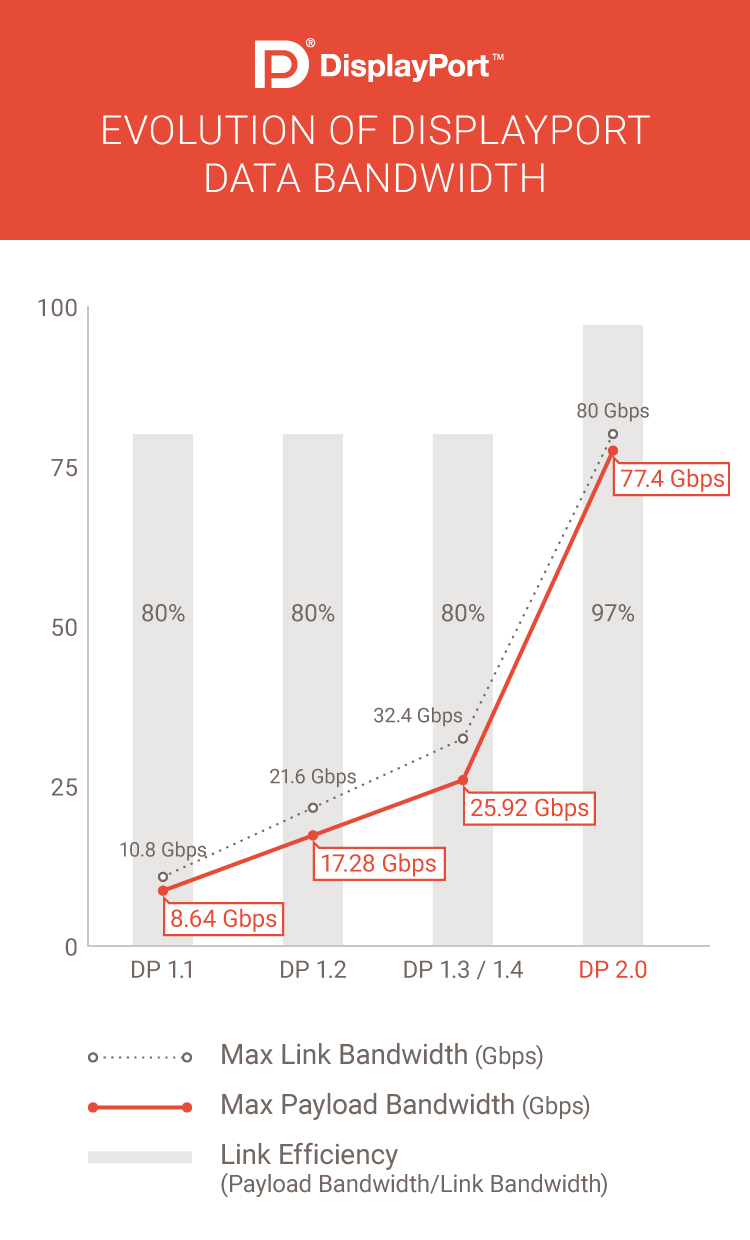With technology evolving faster than our minds can comprehend, hard wiring becomes more advanced beyond belief with each passing day. The addition of the new DisplayPort 2.0 standard, published in June 2019, creates an exciting advantage for consumers who now have a superior connection over the now-aged HDMI cable.
We've seen a lot of exciting features in HDMI 2.1: with the launch of the PS5 and Xbox X Series, HDMI 2.1 allows us to play majestic games on our TVs at 4K@120Hz high spec, and it supports 8K resolution as well, which allows it to become the essential display port for many high-end 8K TVs released recently.

While HDMI 2.1 has its benefits, the new DisplayPort 2.0 specification allows for resolutions up to an amazing 16K along with higher refresh rates — all thanks to a near-tripled bandwidth over DisplayPort 1.4a. Here's everything you need to know about DisplayPort 2.0.
DisplayPort 2.0 is the first major update to the DisplayPort standard since March 2016, and provides up to a 3X increase in data bandwidth performance compared to the previous version of DisplayPort (DP 1.4a), as well as new capabilities to address the future performance requirements of traditional displays.
These include beyond 8K resolutions, higher refresh rates and high dynamic range (HDR) support at higher resolutions, improved support for multiple display configurations, as well as improved user experience with augmented/virtual reality (AR/VR) displays, including support for 4K-and-beyond VR resolutions.

DisplayPort 2.0 increases the maximum bandwidth to up to 77.37Gbps, according to VESA. That is a significant increase over DisplayPort 1.4a, which only achieves 25.92 gigabits per second across all four lanes.
DisplayPort 2.0 vs DisplayPort 1.4
| Resolution | Refresh Rate | DisplayPort 1.4 | DisplayPort 2.0 | |
| 2K | 2560x1440 | 240Hz | √ | √ |
| 4K | 3840x2160 | 60Hz | √ | √ |
| 4K | 3840x2160 | 120Hz | √ | √ |
| 4K | 3840x2160 | 144Hz | √ (DSC or 4:2:2) | √ |
| 4K | 3840x2160 | 240Hz | √ (DSC or 4:2:0) | √ |
| 8K | 7680x4320 | 60Hz | √ (DSC or 4:2:0) | √ |
| 10K | 10240x4320 | 60Hz | × | √ |
| 16K | 15360x8640 | 60Hz | × | √ (DSC) |
DisplayPort 2.0 handles a hefty 15360x8460 resolution (16K) with HDR at 60Hz and up to 30 bits per pixel (30 bpp). This requires VESA's Display Stream Compression (DSC 1.2a) to push the high pixel count across current hardware limitations. DSC promises a "lossless" experience, meaning you won't lose visual quality due to compression. DisplayPort 2.0 also supports a 10240x4320 (10K) resolution without HDR at 80Hz and up to 24 bpp. This single-screen resolution does not require compression.
The connector shape for DP 2.0 remains unchanged, and it is also backward compatible with the previous version of the DisplayPort protocol. In addition, DP 2.0 continues to support DP Alt Mode, which has been well received for its ability to be used on USB-C ports.
Alongside raw bandwidth improvements, DisplayPort 2.0 also has a few enhancements on the feature front, one of which is Panel Replay. This makes the display work more efficiently by limiting the power it uses and decreasing the thermal output. For example, with Panel Replay enabled, a smaller device with a high-resolution display only updates elements that change on-screen.
The following table compares the main functional differences between the latest generation of HDMI and DisplayPort protocols:
| DisplayPort 2.0 | HDMI 2.1 | |
| Released | 2019 | 2017 |
| Bandwidth | 77Gbps | 40Gbps |
| Max resolution | 16K(15360x8640) | 10K(10240x4320) |
| Numbers of supported displays | 4 (MST) | 2 |
| Display Stream Compression (DSC) | √ | √ |
| High Dynamic Range(HDR) | √ | √ |
| Variable Refresh Rate(VRR) | √ | √ |
| Enhanced Audio Return Channel(eARC) | × | √ |
| Auto Low Latency Mode(ALLM) | × | √ |
| Quick Frame Transport(QFT) | × | √ |
| Daisy Chaining | √ | × |
Game consoles and TVs with HDMI 2.1 are already available, but DP 2.0 monitors and other hardware are still awaited, there is only one processor that supports it: Ryzen 6000 mobile integrated graphics. DP 2.0, especially when used with USB-4, looks like a really great solution for the increasing bandwidths and complexities of desktops. We just need to start seeing more products in the market. As a professional AV & video signal adapter provider, Fullink is developing DP 2.0 cables and adapters, and new products are coming soon.
It's backward compatible with all previous DisplayPort standards. Like DisplayPort 1.4, the new standard works with USB-C ports supporting "DP Alt Mode". Here, you can have a single cable for both video and data, enabling high-speed data delivery without compromising video performance.
DisplayPort 2 supports 8K, 10K, and 16K video resolutions with a 60 Hz refresh rate (twice the resolution and bandwidth of current DisplayPort standards). It transfers data at a rate of 77.37 Gbps, and it will have HDR10 support.
If you're a gamer, you're probably not using a very high-resolution display screen. For gamers, a higher refresh rate is more important than a higher resolution, so a DP 1.2 cable already meets the needs of most gamers. If you want to play games at a high refresh rate of 144Hz on a 4K monitor, buying a DP 1.4 cable will also suffice. If you own one of those shiny new top-end gaming monitors that may be pushing the limits of DP 1.4, you can grab a DP 2.0 cable and get ready for the future.